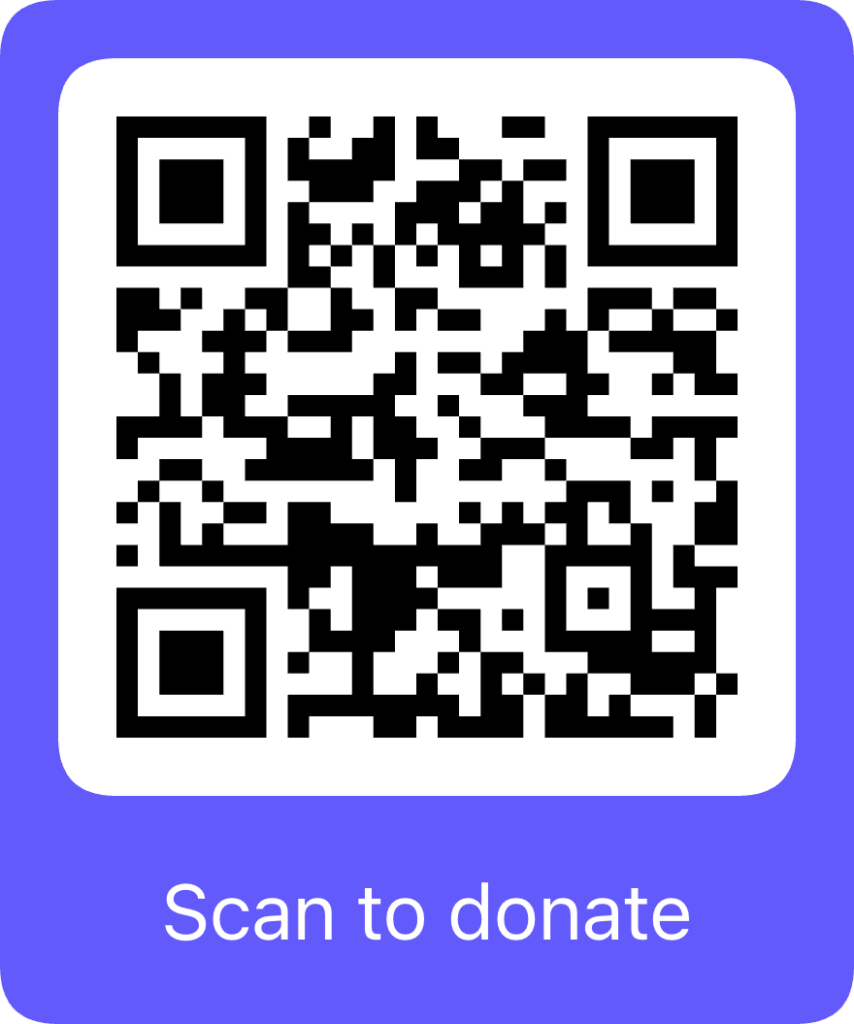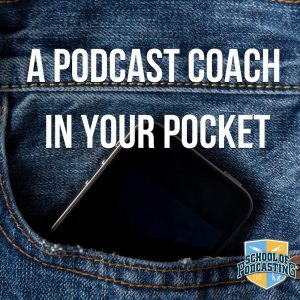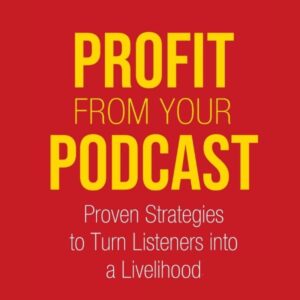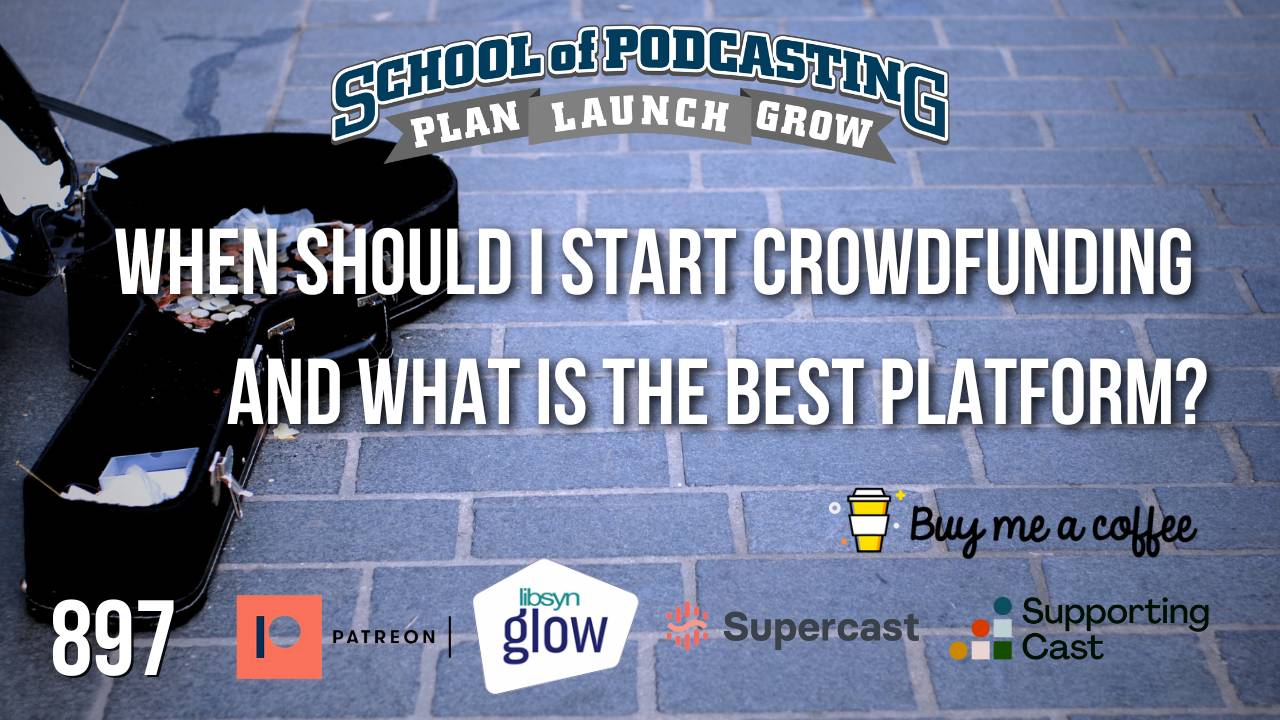
There are people making six-figure incomes PER MONTH using crowdfunding. That sounds AMAZING, and today I share with you the pros and cons of some platforms along with some grim facts to set you straight with a proper attitude so you don't quit before you start.
Join the School of Podcasting
 This show is brought to you by the #1 website dedicated to helping people plan, launch, grow, (and if you want to ) monetize their Podcast – The School of Podcasting.
This show is brought to you by the #1 website dedicated to helping people plan, launch, grow, (and if you want to ) monetize their Podcast – The School of Podcasting.
Are you looking to start your podcast but don't know where to begin? Look no further than the School of Podcasting. Our comprehensive online courses and one-on-one coaching will teach you everything you need to know, from equipment and editing to marketing and monetization. With our proven methods and expert instructors, you'll create high-quality, engaging content in no time. Say goodbye to the frustration and uncertainty and hello to a successful podcasting career with the School of Podcasting.
Why Crowdfunding?
If you're looking to get a “big sponsor” like Better Help, Athletic Greens, etc you will need at least 10,000 per episode after 30 days. This excludes about 90% of most podcasts. This doesn't mean you can't have ads. I get around 2000 downloads per episode, and I still had a microphone sponsor, an editor, and other products that fit my audience. So it's not a death sentence if you don't get 10,000 downloads. You may be eligible for programmatic ads if you get 10,000 downloads per month. Currently, host reads ads are around $25 CPM (price per 1000 downloads), and programmatic ads are anywhere from $5-10 CPM.
The Most Profitable Strategy With Your Podcast Is Not Advertisements
The most profitable strategy with your podcast is creating a show for your target audience and then “Sponsor” your own show. As you may spend $20 or less monthly to syndicate your podcast, a new client could easily have your showing profit for your effort. I'm not “Anti-Advertisement,” but I want to inform you of other strategies.
Some People Are Making Insane Amounts of Money Using Crowdfunding
According to Graphtreon:

The Harsh Truth of Audience Engagement
I heard an episode or Radio Lab where they were doing a fundraiser and said they were trying to get up to 1% of their audience chipping in. When I spoke with a representative from Teachable, they quoted 2% of your audience. When I interviewed people for my book Profit From Your Podcast: Proven Strategies to Turn Your Listeners Into a Livelihood, I heard the number 3%.
Adam Curry the co-host of No Agenda Show, said in a recent episode of the Podcasting 2.0 show they the typical engagement is 3-4%. Adam has been sustaining life with his co-host, John C Dvorak, on the No Agenda Show for over a decade.
Remember that if you get 100 downloads per episode and you're really good, you might get three people. Please prove me wrong. I hate this stat, but I see it often.
A Few Things To Consider
When you're ready to launch a crowdfunding campaign, you want to keep a few things in mind:
- How often do you get paid
- Is there a minimum payment threshold
- How easy is it to listen to your premium feed
- What percentage of the revenue does the podcaster get to keep?
If your audience isn't that technical, saying, “Copy and paste the feed into your favorite app,” may be MILES above their head. So, will you be the tech support, or can you send questions to the platform you are using?
You want to look for any hidden fees. For example, Spotify charges you .20 every time you get paid on top of the percentage they took. This could add up over a year if you want to be paid frequently.
How easy is it to purchase your membership? If you have to send them to another site, that is one more click that may result in a loss of sales.
Who Takes The Least Amount of Money?
If you're only worried about take-home money, this chart shows the take-home of the average pledge ($7). Keep in mind this includes Spotify, which charges .20 every time you remove your own money. This Supporting Cast information is from a brochure I got at Podcast Movement; for some very frustrating reason (for me) they do not list their fees on their website (only a “schedule a demo, and a list of famous podcasters who use their platform).
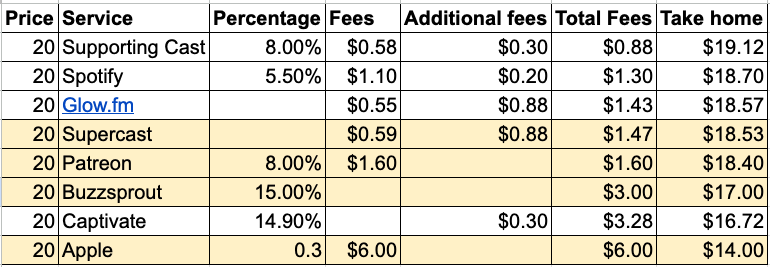
At first, it seems like Supporting Cast is the top choice – if you can get in. There is no “sign up now” on the Supercast website, so they may not accept just anybody (more on that later). This might make you want to go with Spotify, except that means you're forcing your audience to listen on Spotify. After spending hundreds of millions of dollars, I believe we can come to the conclusion that Spotify has proven that many listeners don't want to switch apps to hear a show.
This leads to Glow and Supercast. The difference between these two is Glow can work with any media host, but that means you have to go buy a hosting plan from someone like Libsyn (prices start at $5/month), whereas Supercast already provides hosting and stats. Also, Supercast enables you to make multiple plan levels and the ability to email your members.
Keeping It All Under One Roof
If you want to keep things all under one roof, Buzzsprout (aff) has a simple interface that makes it easier for your audience to listen, while Captivate (aff) requires your audience to copy and paste the feed link (but Captivate also offers the ability to do a one-off tip). Captivate also makes it easier to put past episodes behind a paywall and give your listeners early access. Both Captivate and Buzzsprout put links to your premium offering in every episode.
Captivate also works with Zapier so if you have a membership site using something like Heartbeat, you could easily add them to a private feed for no cost.
What If I Just Want To Accept Money and Not Provide Premium Content?
When you first start, you're trying to GROW your audience, and the thought of creating a second show (your premium content) could be overwhelming. So you may want just to have an option to say thanks by giving you money (some people call this tipping). Here is a chart showing different platforms.

Here, Stripe and Glow don't add any additional fees on top of the credit card processing. Of those two, Glow would be easier to setup, but you need to point your audience at your Glow landing page to use it. Stripe provides code you can embed on your site, requiring one less click to donate. Stripe is typically used as a service you integrate with a service like Teachable, Zenler, etc. It's not hard to make a button, but because stripe is more of a ‘Back end” tool, you will need to look up their help document to set this up. Once it is set up you get a link, a QR code, and a code to put on your website like this one.
Things That Make You Go Hmmm Paypal and Patreon
Paypal has or had, or maybe has an item that if you spread false information (voted on by Paypal) they can fine you $250,000 see this article.
If you Google the phrase Patreon Censorship, you get a pile of results. Granted it is the Internet, but again… hmmm. Not only does your podcast have to follow the rules, but so does YOUR LIFE.
Why I Worry About Your Starting a Crowdfunding Campaign
There are 24 hours a day, and let's say you get 61 downloads when you publish an episode. When you start to focus more on monetization, if you are a one-person crew, you are taking time away from marketing and growing your audience. You get two people (if you're really good) to subscribe and conclude that it's not worth the effort, and you quit.
This is why it is SO important that you know your WHY and your WHO. If the WHY was to have fun, keep doing it for fun. Then, later, when you have a larger audience, you can return to this idea. This enables you to focus on making GREAT content that will inspire your audience to tell a friend.
When you ADD additional effort to monetize, you might be taking up all the “spare time” you have in your schedule, and when the returns are low, it can be soul-crushing.
So, like a fisherman, put your pole in the water and let the audience know they can now support you if they desire, but also, when you first start you may only get a few nibbles.
The Call To Action When You Start
I was listening to the Buzzcast where they talked about this subject, and one of the hosts mentioned that when you do a call to action on your early shows in the future, if people go to listen to your older shows, they will hear the call to support the show monetarily. I can see that point of view. However, as the typical path is plan, launch, grow, and monetize, I would feel a better call to action in your early shows would be TELL A FRIEND.
Another Way To Monetize: Value for Value
Look. I get it. You can barely pronounce cryptocurrency, let alone integrate your show with it. Well, if you can copy and paste, you can set up your show so that the longer your audience listens the more money you earn. All you need to do is copy and paste a few things. This 5-minute video shows you how to set up your show. Over the last few months, I've paid $62 to different podcasters (I add $ per month to my wallet at Alby, and when it's gone, it's gone – write good episode titles to get my attention).
Meanwhile, I've received $137.13, and as I look at my stats, do you want to guess what percentage is sending me Satoshis?
You guessed it. 3%
Conclusion
Crowdfunding can be a great way to monetize your podcast but remember, it is only ONE way to monetize your show. In my discussions with full-time podcasters, it is ONE of MANY income streams (ads, affiliates, donations, etc). One should examine how easy it is to order your subscription, how easy it is for your audience to consume the premium content, and who provides the podcaster with the highest percentage.
Also, when calculating take-home money, put in the amount you want to get. For example, when I put in $7 Buy Me a Coffee looks like a great tool for tips; when I put in $20, I saw where there were better choices.
As I write this in September of 2023, if you want to add crowdfunding, I am impressed with Supercast (aff). I would say Supporting Cast, but I'm not sure they accept any interested podcasters.
If you're not afraid of digging for code, Stripe makes it easy to create a donation link and a QR code that you can put on your website.
Spotify's .20 feed to remove my funds rubbed me the wrong way. Glow.fm makes it easy for the audience to consume the content, but you need to bring your own hosting.
Mentioned In This Episode #897
Join the School of Podcasting Community
Keith Fong Because of My Podcast: Way to the Quality Warrior
Set Up Your Show to Value For Value Video Podcasting 2.0

